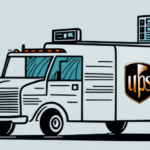As a business owner, understanding the UPS chargeback ground commercial process is essential in keeping your shipping expenses under control. A UPS chargeback is a fee charged by UPS for shipments that do not comply with their shipping guidelines, resulting in additional work for their employees. It's important to know how a UPS chargeback works and the reasons why they occur so that you can avoid them at all costs. Here's what you need to know.
Understanding UPS Chargebacks
What is a UPS Chargeback?
A UPS chargeback is a fee that UPS imposes when a shipment does not adhere to their established shipping guidelines or requires extra handling. These fees can significantly impact your business's profitability if not managed properly. The ground commercial process is the method UPS uses to determine these fees for ground shipping, based on package weight and shipping zone.
How Do UPS Chargebacks Work?
When your package is shipped through UPS, it undergoes an evaluation to ensure it meets all of their shipping guidelines. If the package falls outside these guidelines, UPS will issue a chargeback fee. These fees vary depending on the specific guideline that was not followed and can range from a few dollars to several hundred dollars. It's crucial to dispute any chargeback promptly by providing supporting evidence to avoid additional penalties.
Ground Commercial Rates and Their Impact
What Are Ground Commercial Rates?
Ground commercial rates are calculated based on the shipping zone, weight, and dimensions of the package. The shipping zone refers to the geographic distance between the origin and destination of the shipment, determined by specific zip codes. The weight and dimensions influence the amount of space and resources required during transport.
Calculating Ground Commercial Rates
UPS calculates ground commercial rates using a pricing structure that includes a base rate plus additional fees based on the package's weight, dimensions, and shipping zone. Accurate measurement and classification of your packages are essential to avoid unexpected charges. Businesses can utilize UPS's online shipping calculator to estimate shipping costs accurately.
Common Causes of UPS Chargebacks
Incorrect Weight or Dimensions
Using an unreliable scale or inaccurate measuring tools can lead to discrepancies in package weight or dimensions, resulting in chargebacks. Ensure that all packages are weighed and measured precisely before shipping.
Insufficient Packaging
Improperly packaged items may be damaged during transit, necessitating additional handling by UPS and incurring chargeback fees. Invest in quality packaging materials to protect your products effectively.
Incorrect Label Placement
Proper label placement is crucial. Labels placed incorrectly can cause delays and require extra resources to rectify, leading to chargebacks. Follow UPS’s labeling guidelines meticulously.
Prohibited Items
Shipping items that are on UPS's prohibited list can result in chargebacks and potential legal consequences. Always verify the contents of your packages against UPS’s prohibited items list before shipping.
Late Delivery
Failing to meet promised delivery deadlines can damage your business reputation and lead to chargebacks. Implement reliable shipping schedules and monitor delivery performance closely.
Strategies to Avoid UPS Chargebacks
Double-Check Shipping Information
Ensure that all shipping information, including addresses, weight, and dimensions, is accurate before sending out packages. Incorrect or incomplete information is a common cause of chargebacks.
Utilize Shipping Software
Investing in shipping software that automatically verifies addresses and calculates accurate shipping costs can significantly reduce the risk of chargeback fees. Tools like ShipStation offer robust features for managing shipments efficiently.
Proper Packaging Techniques
Use reliable packaging materials and techniques to protect your items during transit. Proper packaging reduces the likelihood of damage and the need for additional handling by UPS.
Employee Training
Train your staff on UPS shipping guidelines and best practices to minimize errors in packaging and labeling. Well-informed employees are key to preventing chargebacks.
Managing and Disputing UPS Chargebacks
Understanding the Appeals Process
If your business receives a UPS chargeback, you have the right to dispute it through UPS's appeals process. Provide comprehensive evidence, such as photos of properly packaged items, accurate weight and dimension measurements, and proof of on-time delivery, to support your case.
Best Practices for Chargeback Management
- Maintain Detailed Records: Keep meticulous records of all shipments, including packaging details and shipping documents.
- Regularly Review Shipping Data: Analyze your shipping data to identify patterns that may lead to chargebacks and address them proactively.
- Engage with UPS Support: Establish a good relationship with UPS representatives to resolve issues swiftly and prevent future chargebacks.
Leveraging Technology to Reduce Chargebacks
Shipping Management Software
Implementing shipping management software can streamline your shipping processes, provide real-time analytics, and help you make informed decisions to minimize chargebacks. Solutions like Shippo and UPS Shipping Solutions offer tools to enhance shipping efficiency.
Data Analytics
Utilize data analytics to monitor shipping performance, identify areas for improvement, and optimize your packaging and labeling practices. Analyzing trends can help you anticipate and prevent potential chargeback scenarios.
Expert Advice and Future Trends
Staying Informed
Keep abreast of changes in UPS’s shipping guidelines and industry standards. Regularly review UPS updates and participate in relevant training sessions to stay compliant.
Adapting to E-commerce Demands
With the continuous growth of e-commerce, UPS is likely to update its chargeback policies to align with evolving customer expectations. Businesses should remain flexible and adapt their shipping strategies accordingly.
Investing in Sustainable Practices
As sustainability becomes increasingly important, UPS is enhancing its efforts to promote eco-friendly shipping practices. Adopting sustainable packaging and shipping methods can not only reduce chargebacks but also improve your business’s environmental footprint.
By understanding and implementing these strategies, businesses can effectively manage UPS chargebacks, reduce shipping costs, and enhance overall shipping efficiency. Staying informed and leveraging the right tools are key to maintaining profitability and ensuring customer satisfaction in today’s competitive market.




















